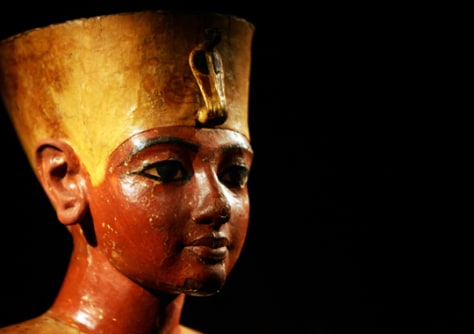Tutankhamun’s tomb
has spiked curiosity since it was first discovered in November of 1922 and
since that time many theories have been developed around the young King, his
early death, and unusual burial. Through this blog we plan to examine the
theory of deification, focusing on the deification of Tutankhamun as
Osiris, while cross-comparing this form of deification with deification from
another culture in order to analyse and critique the theoretical approaches
taken.
When first discovered, Tutankhamun’s burial
tomb was the most complete tomb that had been found in Egypt and therefore was
expected to provide abundant information about Egyptian life. Unfortunately,
although his burial tomb was filled with treasure, Tutankhamun’s mummy has
raised more questions than answers since his discovery over 90 years ago. In order to understand the theory that King
Tutankhamun was mummified as the Egyptian God Osiris, we must first look at the
state Tutankhamun was in when first examined by Howard Carter and Douglas Derry
in November of 1925.
When Howard Carter first removed the thin,
decayed and darkened gossamer linen sheet from Tutankhamun’s second coffin, he
was surprised by the evidence of humidity. Fearing that King Tut had been laid
to rest before he was fully dry and therefore had not preserved well, Carter
was unprepared for what he saw beneath the second coffin (Leek 1972). Upon the
third and last coffin, which was made of gold, Carter found a lustrous black
coating that had been poured over the coffin as a libation during his funerary
rituals. This dark libation, believed to be 46% fats, 19% brown resin, and 35%
unknown brittle organic substances, (Vandenberg 1978) was also found to have
coated King Tutankhamun’s mummified remains, in larger quantities than had ever
been found on any mummy before. As this libation had hardened, it acted much
like a glue adhering Tutankhamun to his coffin, making removal of the mummy
extremely difficult without considerable damage, so the decision to examine
Tutankhamun in situ was made. Carter applied hot paraffin wax to the bandages
surrounding Tut, which were deteriorated, appearing more carbonized the closer
to the body. This is believed to be the result of combustion, due to the overabundance
of the funerary libation, but is currently unproven. Once the paraffin wax had
cooled, Derry made an incision longitudinally down the centre of the outer
wrappings, to just below where the paraffin wax had penetrated and pulled apart
the bandages to reveal the wrappings closer to the body. The consistency of
these are described by Carter as like “soot”, and were thus unable to provide
any definite evidence of the wrapping style used on Tutankhamun. Although the
wrapping style could not be determined, there were anomalies in the wrapping of
Tut, including the choice to mummify Tutankhamun’s penis, which measured 5cm,
in an erect position, while his scrotum was flattened against the perineum.
Also abnormal to this mummification, was the addition an enormous pad of linen,
many centimetres in height on the head of the King, which resembled the manner
of modern surgical bandages in a conical shape, suggestive of a crown (Leek
1972). Each layer of bandages was thus removed, revealing amulets, jewellery
and other treasures between the layers of bandages, until the skin, which was
brittle and carbonized, appearing a whitish grey colour with numerous cracks,
was exposed. This procedure was done in stages, beginning with the knees to the
feet (which were encased in golden sandals), then from the abdomen to the
knees, then the arms, which were laid upon the abdomen with the right forearm
resting on the upper part of the abdomen, the hand on the crest of the left
ilium, and the left forearm lay above it over the lower ribs with the hand
lying on the right side of the thorax between the right upper arm, a position
unusual for Pharaohs of this time. Lastly, the head and chest, which could only
be examined once the golden mask was removed. By using hot knives to heat the
resin, Carter allowed for the careful removal of the King’s head from the mask.
But the resin had made this a difficult process, and having adhered
Tutankhamun’s body to the coffin, Carter decided to dismember the body of
Tutankhamun in order for a proper examination. Derry was thus able to give
Tutankhamun an age of 18 years, based upon the stage of fusion of his epiphyses
on various bones. But most importantly, once Tutankhamun was removed from his
coffin more abnormalities were revealed in his mummification. King Tut had an 86mm
mummification incision, which was smaller than most and in a spot unseen on any
other mummy, but mysteriously, he was also clean-shaven and without pubic hair.
Despite Derry’s close examination of the Tutankhamun’s remains, he could find
no cause of death, much to Carter’s disappointment (Leek 1972).
(Leek 1972, Plate
Xx.)
Although these abnormalities have been the base of many theories, such as evidence of murder or hastiness to mummify young Tutankhamun, it is more likely these abnormalities were done purposely with a symbolic reasoning behind them. Therefore we can consider a few simple questions.
What was the purpose of these anomalies in the mummification of King
Tutankhamun?
Why was Tutankhamun mummified in a way different from most other mummies of the
time?
Was Tutankhamun already considered a deity during his mummification?
Works Referenced:
Leek, F. (1972)
The human remains from the tomb of Tut’ankhamun. Oxford: University Press.
Vandenberg, P. (1978) The Forgotten Pharaoh: The
Discovery of Tutankhamun. London: Hodder and Stoughton Limited.




